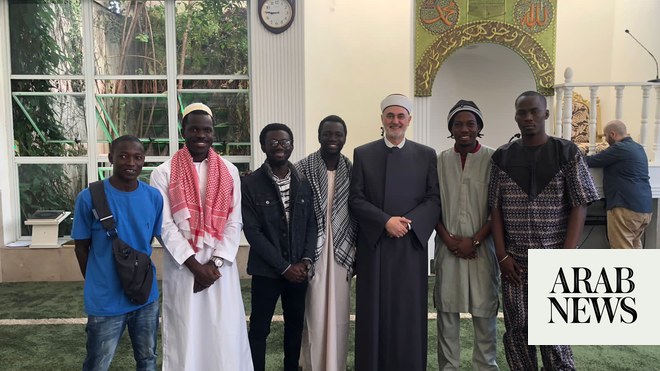
When fire devastated the National Museum in Brazil in 2018, one of the few objects to be found intact among the smouldering ruins was the St Luisa meteorite. While the Rio de Janeiro museum is still being rebuilt, the black rock, around a metre in length, is the star exhibit of the São Paulo Biennial, which opened at the weekend.
The exhibition, now in its 70th year, is the second oldest of its kind. After the Venice Biennale, it is regarded as one of the most important events in the art world calendar.
The curator of the show, Jacopo Crivelli Visconti, says the rock represents a sombre political moment in Brazil with the increasingly embattled far-right president Jair Bolsonaro stoking culture wars in the face of possible impeachment and plummeting popularity.
“The fire at the museum symbolised the attack on culture by this government and governments before it. The museum was long in a state of slow collapse. It was important to have objects from the museum in the show because they are tragic, but also represent resilience. The temperature of the museum fire was nothing compared to the heat the meteorite went through to enter the Earth’s atmosphere.”
Taking inspiration from the rock are a whole series of works spread across the biennal pavilion in São Paulo’s Ibirapuera Park which talk of both trauma and resistance. The dub pioneer Lee “Scratch” Perry, who died a few days before the show, was a notable inclusion. His half-dozen collages and sculptural assemblages include references to Obeah – the spiritual practice developed by enslaved west Africans in the Caribbean – and Christianity, a comment on the role of European missionaries in colonialism. Mauro Restiffe shows two series of photographs, which contrast the inauguration day of former Brazilian president Luiz Inácio Lula da Silva in 2003 with Bolsonaro’s supporters celebrating the day the current president entered office. The first the artist has titled simply Inauguration, the second Unspeakable.
“The show also amounts to a very clear gesture of solidarity with the indigenous people of this land,” Crivelli says. A sound piece by Sueli Maxakali relays the traditional chants of the Tikmu’un people. A series of photographs by queer performer Uyra, who is of Munduruku descent, see the artist almost camouflage to the forest behind them, their face painted and wearing costume made from the surrounding foliage. Other images by the artist show them against a heavily polluted backdrop, a nod to the current destruction being wrought by miners and farming on indigenous land. On a lake outside the venue, close to a statue marking the colonial exploration of Brazil, artist Jaider Esbell has installed a pair of 17-metre inflatable snakes. The intricately patterned creatures are a sign of abundance and offer protection to the Makuxi people.
“We wanted to make it very clear as a curatorial group where we stand,” Crivelli adds. “We stand on the side that defends indigenous rights, defends social rights, gender-identity rights.”
A series of paintings by Daiara Tukano feature birds sacred to the Tukano, a group of communities whose lands span the modern borders of Brazil, Colombia and Venezuela. The artist arrived for the opening of the exhibition from Brasilia, the Brazilian capital, where more than 6,000 representatives of 176 Indigenous groups have been staging a week-long occupation. Their protest concerned a land rights bill currently going through the courts. The government-backed ruling will see indigenous territory limited only to the areas occupied in 1988, the year of the current Brazilian constitution.
“Being part of the biennal is a war strategy,” Daiara says. “It is a step through which we seek to go to institutions elsewhere in Brazil and in Europe, to all the places where for hundreds of years decisions were made without us. Our participation here says in a very clear way, nothing more will be decided about our territories without us.
“It has not been long that we have had full access to democracy, so it is paramount that we make people understand we are human, that we exist and that we represent cultural diversity, a diversity of science, a diversity of cosmo-visions, different ways of seeing the universe.
“This is not my art,” Daiara says, gesturing to the works around her. “This belongs to my nation, this is something that belongs to my ancestors, ancestors who are here standing with me.”
Was Visconti worried, given the political nature of the exhibition, that it would be attacked by Bolsonaro loyalists? A statement made by Mário Frias, Brazil’s secretary of culture, in a video acknowledging government support of the biennal, uses the inflammatory rhetoric that typifies the current administration, demanding that public arts spending be reserved for the “great classics of our culture”.
“Let men be free and they will create a rich culture without public funds,” the soap star turned politician says. “Let’s rescue the main values of public policy for culture. For without culture there is not even the idea of people or man, there are only a handful of bipedal animals.”
Visconti says: “We were worried that there might be groups that try to make trouble. But I think one of the big dangers to face in moments like this is self-censorship, self-censorship is way worse than censorship. When censorship happens you fight it, self-censorship is subtle and there is no way of dealing with it. We haven’t had any intervention from anyone while making the show and now it’s out there for the public.”











